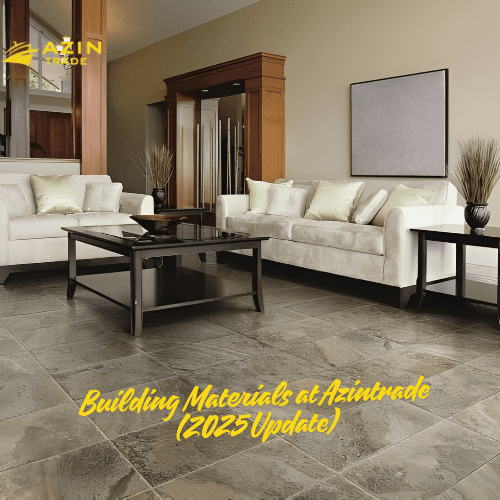Floor Tiles : A Comprehensive Guide for Modern Homes and Businesses
Floor tiles have become one of the most reliable and stylish flooring solutions in the world. They combine strength, beauty, and functionality, making them the perfect choice for residential houses, commercial buildings, and even outdoor spaces. Whether you’re designing a new property or renovating an old one, floor tiles give you endless opportunities to create durable and attractive interiors.
In this ultimate guide, we will explore everything you need to know about floor tiles — from types and materials to design tips, installation, maintenance, costs, and even upcoming trends in flooring.
What Exactly Are Floor Tiles?
Floor tiles are durable, flat pieces made of ceramic, porcelain, stone, vinyl, or other materials designed specifically for covering floors. They are built to resist wear, handle heavy foot traffic, and withstand environmental conditions. Unlike wood or carpet, tiles for flooring are easy to maintain and come in a wide range of styles.
Throughout history, civilizations have used tiles to decorate and protect their spaces. From Roman mosaics to Persian palaces, tiled floors have always been associated with beauty and durability. Today, they remain one of the best flooring options for modern construction.
Why Choose Floor Tiles?
When deciding on flooring, people often compare options like hardwood, laminate, or carpet. However, floor tiles consistently stand out for their versatility and performance.
Main Advantages
-
Durability: Can last decades with minimal damage.
-
Moisture resistance: Ideal for kitchens, bathrooms, and laundry rooms.
-
Low maintenance: Simple cleaning keeps them fresh.
-
Variety: Available in thousands of patterns, colors, and textures.
-
Eco-friendly choices: Many tiles are made with sustainable materials.
-
Hygiene: Do not trap dust, dirt, or allergens.
Moreover, tiles can replicate other materials such as wood or stone while offering better resistance against scratches and stains. This makes them both practical and stylish.

Types of Floor Tiles
Different projects require different materials. Let’s look at the most common types of tiles for flooring.
Ceramic Tiles
Ceramic floor tiles are popular because they are affordable, versatile, and easy to install. Available in endless designs, they suit areas with low to medium traffic.
Porcelain Tiles
Porcelain is denser and more water-resistant than ceramic. It’s excellent for high-traffic zones like hallways, kitchens, and commercial spaces. Moreover, porcelain tiles often mimic natural stone or hardwood floors, making them both functional and elegant.
Natural Stone Tiles
Marble, granite, slate, and travertine offer timeless luxury. Each stone tile has unique patterns, making every floor one of a kind. However, stone flooring is usually more expensive and requires sealing.
Vinyl Tiles
Vinyl floor tiles are budget-friendly, soft underfoot, and easy to install. They are particularly useful for families with children or pets because they resist moisture and scratches.
Glass Tiles
Glass is less common for full floors but is often used for accents or creative designs. It reflects light beautifully and works well in modern interiors.
Choosing the Right Floor Tiles
Selecting the right flooring involves balancing cost, design, and function.
-
High traffic areas: Choose porcelain or stone for strength.
-
Moisture-prone rooms: Go for porcelain or vinyl.
-
Budget: Ceramic and vinyl are cost-effective, while marble is premium.
-
Design preferences: Rustic, minimalist, or luxurious? Each has a matching tile.
-
Size and layout: Large-format tiles create a seamless look, while smaller tiles allow intricate patterns.
For example, if you’re renovating a kitchen, porcelain tiles with slip-resistant finishes are best. On the other hand, for bedrooms, ceramic or vinyl works well for a cozy yet durable space.
Floor and Layouts
The way you lay tiles affects the overall look of your room.
-
Straight lay: Simple and classic.
-
Diagonal layout: Adds elegance and creates the illusion of more space.
-
Herringbone: A sophisticated zigzag design.
-
Basket weave: Traditional and textured.
-
Chevron: A bold, modern style.
Pattern choice can also impact installation costs, so plan carefully.

Installing Floor Tiles
Proper installation ensures durability and performance.
Steps for Installation
-
Prepare the surface — clean, level, and free of dust.
-
Plan your layout before fixing tiles.
-
Apply adhesive with a notched trowel.
-
Place tiles with spacers for even gaps.
-
Apply grout once adhesive dries.
-
Seal if using natural stone.
Although DIY installation is possible, hiring professionals guarantees better results.
Maintaining Floor Tiles
One of the best things about tiles is that they are easy to maintain.
-
Sweep or vacuum regularly.
-
Mop with mild cleaners.
-
Avoid abrasive tools that scratch surfaces.
-
Reseal natural stone every few years.
-
Replace broken tiles immediately.
Consistent care ensures your flooring looks new for decades.
Floor Tiles by Room
Living Room
Porcelain tiles that mimic wood create a cozy yet modern look.
Kitchen
Slip-resistant porcelain or ceramic tiles are ideal.
Bathroom
Waterproof porcelain and natural stone tiles work best.
Bedroom
Vinyl or ceramic tiles add comfort and practicality.
Outdoor Spaces
Frost-resistant stone or textured porcelain ensures durability.

Current Trends in Floor Tiles
-
Wood-look porcelain: Combines style with durability.
-
Large-format tiles: Fewer grout lines and a sleek finish.
-
Textured finishes: Add depth and interest.
-
Eco-friendly materials: Sustainable ceramics and recycled glass.
-
Mixed designs: Combining tiles with wood or concrete.
Pros and Cons of Floor Tiles
Advantages
-
Long-lasting durability
-
Easy cleaning
-
Huge design flexibility
-
Hygienic for homes with allergies
-
Suitable indoors and outdoors
Disadvantages
-
Can be cold underfoot
-
Hard surface may be uncomfortable for long standing
-
Premium tiles can be costly
-
Installation requires skill
Cost of Floor Tiles
Prices vary depending on material and brand.
-
Ceramic: $2–$10 per sq. ft.
-
Porcelain: $4–$15 per sq. ft.
-
Stone: $7–$30 per sq. ft.
-
Vinyl: $1–$5 per sq. ft.
Installation can add $4–$10 per sq. ft.
Future of Floor Tiles
The flooring industry is evolving rapidly. Expect innovations like:
-
Smart tiles with heating or LED lighting
-
Eco-friendly tiles from recycled materials
-
3D printed custom designs
-
Ultra-thin tiles for easy installation
Conclusion
Floor tiles are more than just a practical flooring solution; they are a foundation for modern living. With endless choices in design, material, and cost, they can fit any lifestyle or budget. By understanding the different types, installation techniques, and maintenance needs, you can create stylish, durable, and functional spaces that last for decades.
From homes to offices, kitchens to patios, floor tiles continue to be the flooring of choice for people around the world.
FAQs About Floor Tiles
1. Which floor tiles last the longest?
Porcelain and natural stone tiles are the most durable.
2. Can floor tiles be used outdoors?
Yes, but choose frost-resistant stone or porcelain for weather resistance.
3. Are ceramic tiles suitable for bathrooms?
They can be, but porcelain is more water-resistant.
4. How often should natural stone tiles be sealed?
Every 2–3 years depending on usage.
5. Are vinyl tiles a good option for families?
Yes, they are affordable, water-resistant, and safe for children and pets.



